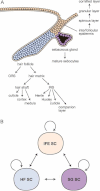Epidermal stem cell diversity and quiescence
- PMID: 20049729
- PMCID: PMC2850061
- DOI: 10.1002/emmm.200900033
Epidermal stem cell diversity and quiescence
Abstract
Mammalian epidermis is maintained by self-renewal of stem cells and terminal differentiation of their progeny. New data reveal a diversity amongst stem cells that was previously unrecognized. Different stem cell populations have different locations and differ in whether they are quiescent or actively cycling. During normal epidermal homeostasis, each stem cell population feeds a restricted number of differentiated lineages. However, in response to injury or genetic manipulation the different pools of stem cells demonstrate multi-lineage differentiation ability. While it is well established that Wnt signalling promotes hair follicle (HF) differentiation, new observations suggest a role for EGF receptor signalling in promoting differentiation of interfollicular epidermis. NFATc1 maintains quiescence in the HF, while Lrig1 exerts the same function in the junctional zone. The stage is now set for exploring the relationship between the different epidermal stem cell populations and between quiescence and lineage selection.
Figures

The differentiated lineages of the interfollicular epidermis (IFE), sebaceous gland (SG) and hair follicle (HF) are shown. ORS, outer root sheath; IRS, inner root sheath.
In response to appropriate stimuli, stem cells (SC) in any region of the epidermis can give rise to any of the epidermal differentiated lineages. SCs are therefore represented as being interconvertible. Based on Owens and Watt (2003).


Similar articles
-
Lrig1 expression defines a distinct multipotent stem cell population in mammalian epidermis.Cell Stem Cell. 2009 May 8;4(5):427-39. doi: 10.1016/j.stem.2009.04.014. Cell Stem Cell. 2009. PMID: 19427292 Free PMC article.
-
Differential response of epithelial stem cell populations in hair follicles to TGF-β signaling.Dev Biol. 2013 Jan 15;373(2):394-406. doi: 10.1016/j.ydbio.2012.10.021. Epub 2012 Oct 26. Dev Biol. 2013. PMID: 23103542
-
CD4 expression controls epidermal stem cell balance.Sci Rep. 2025 Feb 4;15(1):4185. doi: 10.1038/s41598-025-87915-7. Sci Rep. 2025. PMID: 39905055 Free PMC article.
-
Designer skin: lineage commitment in postnatal epidermis.Trends Cell Biol. 2002 Apr;12(4):185-92. doi: 10.1016/s0962-8924(02)02263-8. Trends Cell Biol. 2002. PMID: 11978538 Review.
-
Epithelial stem cells and implications for wound repair.Semin Cell Dev Biol. 2012 Dec;23(9):946-53. doi: 10.1016/j.semcdb.2012.10.001. Epub 2012 Oct 17. Semin Cell Dev Biol. 2012. PMID: 23085626 Free PMC article. Review.
Cited by
-
Tooth, hair and claw: comparing epithelial stem cell niches of ectodermal appendages.Exp Cell Res. 2014 Jul 15;325(2):96-103. doi: 10.1016/j.yexcr.2014.02.003. Epub 2014 Feb 14. Exp Cell Res. 2014. PMID: 24530577 Free PMC article. Review.
-
Basal Cells in the Epidermis and Epidermal Differentiation.Stem Cell Rev Rep. 2022 Aug;18(6):1883-1891. doi: 10.1007/s12015-021-10256-1. Epub 2022 Jan 26. Stem Cell Rev Rep. 2022. PMID: 35080747 Review.
-
Targeted inactivation of integrin-linked kinase in hair follicle stem cells reveals an important modulatory role in skin repair after injury.Mol Biol Cell. 2011 Jul 15;22(14):2532-40. doi: 10.1091/mbc.E11-01-0035. Epub 2011 May 18. Mol Biol Cell. 2011. PMID: 21593206 Free PMC article.
-
aPKCλ controls epidermal homeostasis and stem cell fate through regulation of division orientation.J Cell Biol. 2013 Sep 16;202(6):887-900. doi: 10.1083/jcb.201307001. Epub 2013 Sep 9. J Cell Biol. 2013. PMID: 24019538 Free PMC article.
-
Deciphering neural heterogeneity through cell lineage tracing.Cell Mol Life Sci. 2021 Mar;78(5):1971-1982. doi: 10.1007/s00018-020-03689-3. Epub 2020 Nov 5. Cell Mol Life Sci. 2021. PMID: 33151389 Free PMC article. Review.
References
-
- Alonso L, Fuchs E. The hair cycle. J Cell Sci. 2006;119:391–393. - PubMed
-
- Andl T, Reddy ST, Gaddapara T, Millar SE. WNT signals are required for the initiation of hair follicle development. Dev Cell. 2002;2:643–653. - PubMed
-
- Arnold I, Watt FM. c-Myc activation in transgenic mouse epidermis results in mobilization of stem cells and differentiation of their progeny. Curr Biol. 2001;11:558–568. - PubMed
Publication types
MeSH terms
Grants and funding
LinkOut - more resources
Full Text Sources
Medical
Research Materials
Miscellaneous

